Marble is such a gorgeous material to use in a home. The natural stone instantly adds a sophisticated touch to a room, whether you have tiles or a benchtop.
The catch? Marble is a porous stone, so it’s a bit tricky to keep clean.
Water spots, soap scum, and other residue show up very easily on marble. Stains can set due to the porous surface. This makes it important to know how to clean marble with the right methods.
The best way to clean marble is a solution of mild dish detergent and warm water. Then use a soft cloth to wash the surface, before rinsing and drying.
But for a complete marble cleaning guide, we’ll talk about how to tackle different surfaces or areas, including:
You’ll also get tips on what products to use and what to avoid, methods for removing stains, and how to deal with scratches.
With proper care, marble can last a lifetime – so don’t skimp on maintenance!
Before Cleaning A Marble Surface: What to Know
Marble is a soft and porous natural stone, so it requires a bit more care to maintain.
There are some cleaning solutions to avoid so you don’t accidentally damage the material.
Check in with your house cleaner about any marble surfaces in your home so they know to use the appropriate products.
What cleaning products are safe to use on marble?
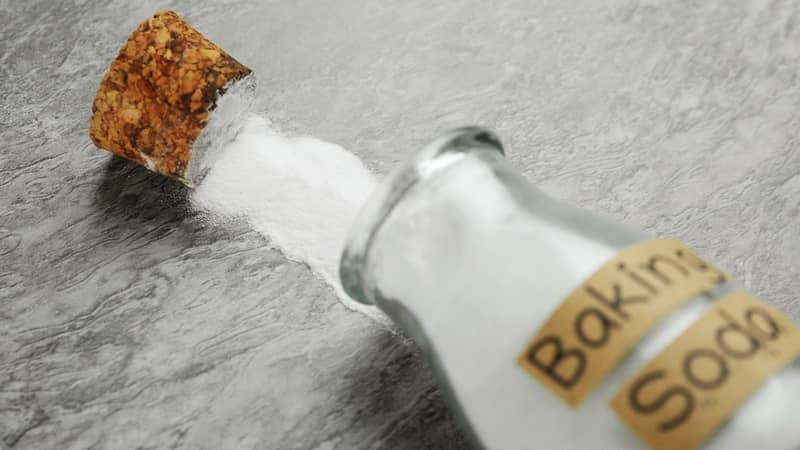
To avoid damaging marble when cleaning, you’ll need to be mindful of the products you use.
Some recommended solutions include:
- Mild dish soap or detergent
- Isopropyl or rubbing alcohol
- Hydrogen peroxide (light-coloured marble only)
- Baking soda and cornstarch
You can also get a specialised marble cleaner such as Black Diamond Stoneworks Marble & Tile Floor Cleaner or Weiman Granite Cleaner & Polish.
Other materials safe for marble include microfibre or soft cotton cloths, paper towels, and #0000 steel wool.
If you need to scrape something off, use a silicone scraper.
What not to use on marble surfaces
Since marble is a natural stone, there are several cleaning solutions you cannot use to clean it. These could damage or degrade the marble surface.
Cleaning products to avoid using on marble surfaces include:
- Vinegar, lemon juice, and most strong acidic cleaners
- Citrus-based products
- Abrasive cleaners
- All-purpose cleaners (unless specially formulated for stone)
- Bleach-based cleaners
- Ammonia
It’s also best to avoid abrasive sponges and steel wool above #0000 (super-fine), as well as metal tools (e.g. metal brushes).
Does marble need to be sealed?
Yes, you do! Marble has a porous surface, so it will absorb anything it comes into contact with.
Sealing marble is a crucial part of maintenance, as it makes the surface more water and stain-resistant.
How often to seal marble will depend on where it is and how it’s used. For high-traffic or high-use areas, reapply the sealant once a year.
Alternatively, you can check the seal by performing a water test. If you pour a small amount of water on marble and it doesn’t bead on the surface or if it stains, you need to seal the surface.
How to Clean a Marble Benchtop
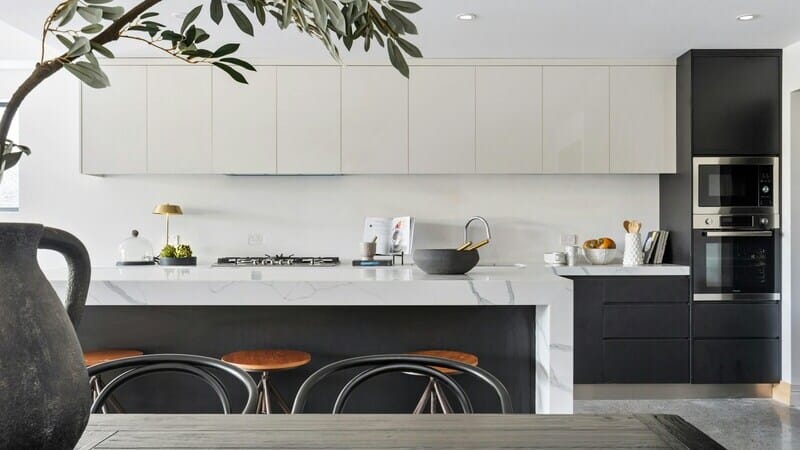
Maintaining a marble benchtop requires extra vigilance since it’s constantly exposed to food, drinks, and hot kitchenware.
Be sure to use trivets and coasters when setting down hot kitchenware or plates! And of course, use cutting boards when preparing food – no knives on a marble surface.
How often to clean marble benchtops
Wipe or blot spills immediately.
Clean the benchtop daily with detergent and water.
Use a microfiber cloth to dust once a week.
Cleaning marble benchtops
For regular cleaning, your good ol’ dish detergent and warm water are your best friends. Ideally, use a pH-neutral detergent – anti-grease action optional but welcome.
Mix a few drops of the detergent into warm water. Dampen a microfibre cloth with the solution and wipe the marble surface.
Follow with a dry cloth to prevent any water stains.
How to Clean Marble Floors
Marble tiles are a stunning floor material – but maintaining them can be tricky, especially in high-traffic areas!
Place floor mats at entrances to minimise any dirt or mud tracking. If possible, avoid using outside shoes on marble floors.
How often to clean a marble floor
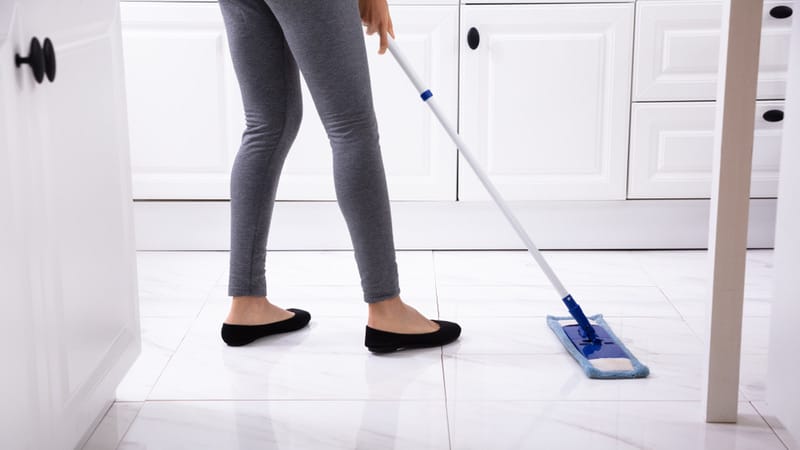
Clean off any mud or spills immediately.
Use a dust mop on a marble floor twice a week to prevent build-up that could lead to scratches.
Deep clean marble tiles around once a month.
Cleaning marble floors
Avoid using a vacuum cleaner on marble floors as the friction could scratch or dull the tiles. The beater bar could also damage the surface.
Instead, start by using a dust mop or a soft broom to remove any dust and debris. This way, you won’t accidentally scratch the surface or push more dirt into the marble.
Use a soap-free cleaner or mild detergent for the floors. Follow product instructions for the mixture (if you’re uncertain, try half a tablespoon per 3 litres) in a bucket, then fill a second bucket with clean water.
Dip a soft mop into the soapy water and wring it out – you want to minimise the moisture. Work in small sections, rinsing the mop frequently and changing out the rinse water.
Once that’s done, rinse the floor with some fresh water to remove any soapy residue. Follow with a microfibre cloth or a mop to dry.
How to Clean a Marble Shower
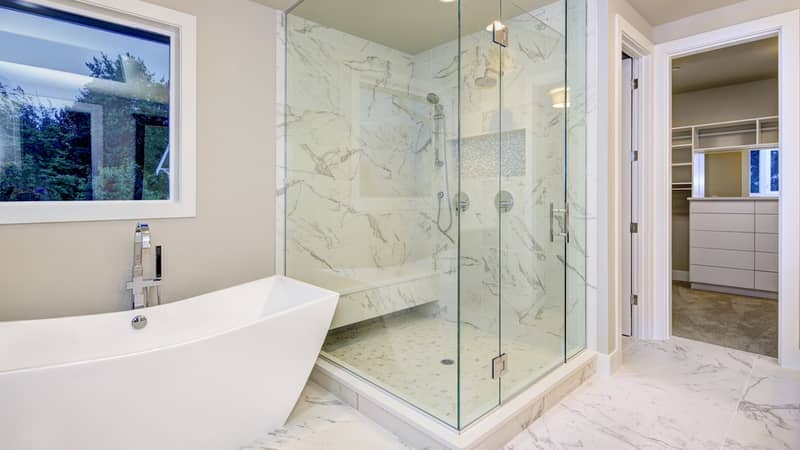
Marble showers will need a bit of extra attention given the exposure to water and soap.
You’ll also need to keep an eye out for mould.
How often to clean marble showers
Much like other types of showers, you’ll need to clean a marble shower once a week.
However, you should also use a squeegee daily (or after every use) to dry the marble tiles. This prevents water stains, which affect the appearance of the marble.
Regular drying will also limit soap scum and prevent mould.
Cleaning marble showers
To clean your marble shower, you can use either a mild dish detergent or a specialised marble cleaner. Avoid anything that has dye or acidic ingredients (such as citrus).
If cleaning with detergent, mix a teaspoon into a spray bottle full of warm water. Saturate the marble, working from top to bottom.
“Scrub” the surface using a microfibre cloth and going in circular motions. Pay close attention to fixtures, corners, and grout lines.
Use the shower to rinse, or wipe the walls with a handheld mop. Squeegee the excess water off the marble surfaces, then follow with a dry cloth.
How to Clean a Marble Table

A marble dining table looks beautiful but needs to be well-maintained. You’ll get a lot of food stains and debris, so be ready and vigilant.
Always use placemats, trivets, and coasters to minimise any chances of damage or staining.
How often to clean marble tables
Clean any spills or stains immediately.
Use the head of a dust mop or a microfibre cloth to dust the table daily.
Wash the table every 2–3 days, or more frequently depending on use.
Cleaning marble tables
Brush off debris from the table using a microfibre cloth or a duster. Remove any tableware or decor as well.
Add a few drops of dish detergent to some water in a spray bottle, then spritz the table surface. Then take a soft cloth and work the surface in gentle, circular motions.
Rinse the cloth frequently to prevent dirt and soap build-up. Finally, lightly dampen a new cleaning cloth and wipe off the soap residue from the surface.
Dry the table completely before putting the settings back.
How to Polish Marble Surfaces

Polishing marble is a key part of maintaining the stone – it’s what makes the surface lustrous and shiny.
You can get DIY marble polish in either chalk or liquid form. Both are easy to use, but chalk-based products take longer to dry.
Do not use products that contain acrylic or polyurethane.
When polishing, work from the centre and work your way outwards. Once you’ve fully applied the polish, follow with a soft cloth to buff the marble.
For buffing, work from the outside going in and use circular motions. Leave the polish to dry, then wipe off any residue.
How to Disinfect Marble Surfaces
Cleaning a surface is different from disinfecting it! Cleaning is simply removing dirt and stains, while disinfecting involves killing germs and bacteria.
It’s best to disinfect marble surfaces that regularly come in contact with food – so benchtops and tables.
Use at least a 70% isopropyl alcohol concentration. Mix equal parts rubbing alcohol and water in a spray bottle.
Lightly spray the marble with the solution, then let it sit for up to 5 minutes. Then dry with a clean cloth.
How to Remove Stains from Marble
It’s essential that you tackle spills immediately – the longer something sits on a marble surface, the more it will absorb into the material.
Use a paper towel to pick up any solids, such as chunks of food.
Then use a soft microfiber cloth to blot any liquid (e.g. sauce) – blot, don’t wipe or rub! That’ll just push the liquid further into the marble.
How to clean liquid stains on marble
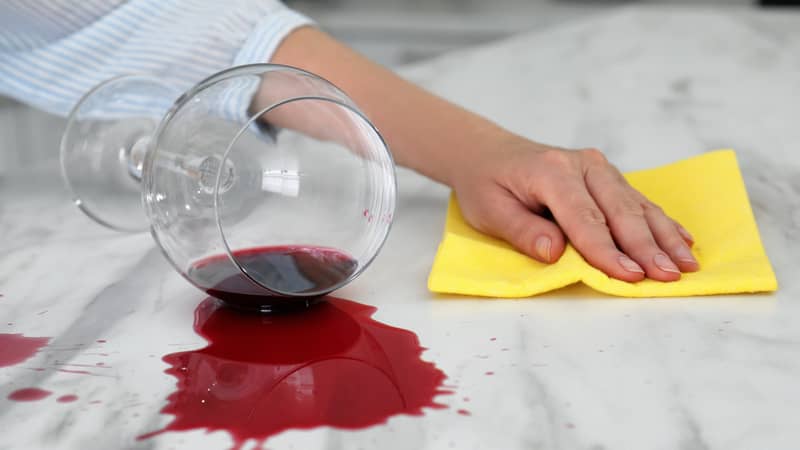
For marble stains from liquids like coffee, wine, and even sauces, use baking soda.
For fresh spills or mild stains, simply sprinkle some baking soda on the affected area. Let it sit for 20–30 minutes to absorb any liquids.
Wipe the residue off with a damp cloth, then dry the surface.
For deeper or more stubborn stains, make a poultice. Mix a tablespoon of baking soda with a few drops of hydrogen peroxide to form a thick paste.
Moisten the stained area with some water, then apply the paste. Cover it with plastic wrap and let it sit for 24–48 hours.
Once the poultice has dried, remove the plastic wrap and use a damp microfibre cloth to wipe off the residue.
Dry the surface immediately. Repeat the process if necessary.
How to clean organic stains or mould on marble
You can use hydrogen peroxide to clean marble surfaces, but be careful! It can discolour dark marble, so it’s best reserved for white or light colours.
This solution works best for organic stains, such as food. It can also be used to clean mould from marble, such as in the shower.
Make sure to tackle spills as soon as they happen. Pick up any solids, then blot away the sauce or liquid with paper towels.
Pour 3% hydrogen peroxide onto the stain, then cover with some plastic wrap. Leave for a day, then wipe any residue with a clean cloth.
For stubborn stains, you can make a paste of 1 part hydrogen peroxide to 2 parts baking soda. Apply the paste to the marble and let it sit for a few minutes.
Wipe the residue off with a damp cloth, then dry the surface.
How to clean oil-based stains on marble
If you’ve spilled grease or oil on marble, cornflour is your best bet.
Sprinkle a good amount of cornflour on the grease or oil stains – enough to cover the affected area. Let it sit for about 20 minutes.
Once the cornflour has absorbed the grease, wipe the residue off with a damp cloth. Follow with a fresh rag to dry.
NOTE: One other way to clean oil stains on marble is with mineral spirits. However, be sure to rinse the surface immediately!
How to Remove Scratches or Etching from Marble
You can tackle light scratches or surface-level scratches using #0000 steel wool. Buff the surface in small, circular motions until the etching has been removed.
Anything deeper will need the attention of a professional.

